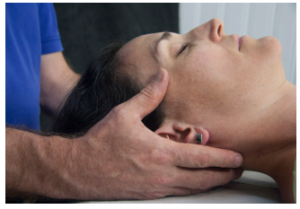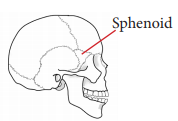 THERAPIST ERGONOMICS
THERAPIST ERGONOMICS
- Elongated spine.
- Pillow is in the terapists’ lap to support forearms.
Most yoga classes end with a relaxation phase called “Shavasana”. This is the Tai Massage version of Shavasana. Sit quietly for several minutes or more, allowing structured time for the client’s cranium to integrate with the body’s newly created space.
CRANIAL ALIGNMENT PHASE:

- Client lies supine.
- Terapist sits superior to the client’s head.
- Terapist rests forearms on a pillow in therapist’s lap.
- Terapist cradles the client’s occiput with fngers of both hands.
- Terapists thumbs very, very lightly contact the right and lef greater wings of sphenoid.
- Terapist hands lightly touch to cradle the temporal bones.
- Terapist’s and client’s eyes are closed.
- Terapist imagines that the client’s head is a giant water balloon with slow, dynamic, intentional, specifc hydrostatic pressure changes occurring. Cranial movement may move away from fngers or into fngers. It is a dance! Back and forth.
- Terapist quietly and gently follows these slow pressure changes giving very mild kinetic energy through the therapist’s hands and fngers to follow and hence facilitate these subtle cranial movements.
- Terapist becomes aware that the erratic cranial unwinding movements have stopped and that the cranium is pulsating in an even tide as the cranium swells and then shrinks back and forth at a rate of 8 to 12 cycles per minute.
- Palpating the cranial rhythms prior to an Assisted Stretching session is unremarkable. Palpating the cranial rhythms just afer an Assisted Stretching session is MIND BLOWING! Te cranium is a microcosm for the body. Te body has just been dramatically opened by making space with Assisted Stretching, now the cranium wants to assimilate this new found relaxation. Te therapist is not putting cranial bones in place, the therapist is following cranial bones into place with gentle kinetic energy. In Osteopathy, this is called an “Indirect Technique” when the cranium moves into the fngers and is a “Direct Technique” when the cranium moves away from the fngers
EXERCISE:
- Contact your right sphenoid (see #2 on drawing) with your right middle finger, contact the left sphenoid with your left middle finger. Push left sphenoid to right in horizontal plane and feel the right sphenoid move. Push right sphenoid left and feel the left sphenoid move. Thus, proving cranial bones have motion! Te cranium has 23 bones that are in motion.
